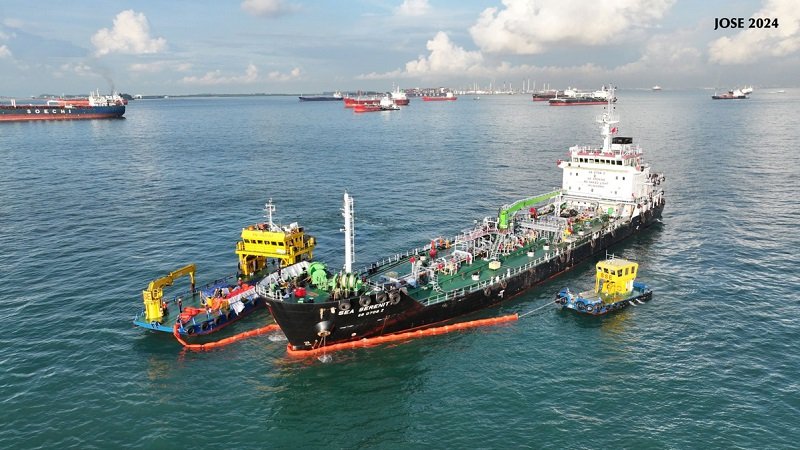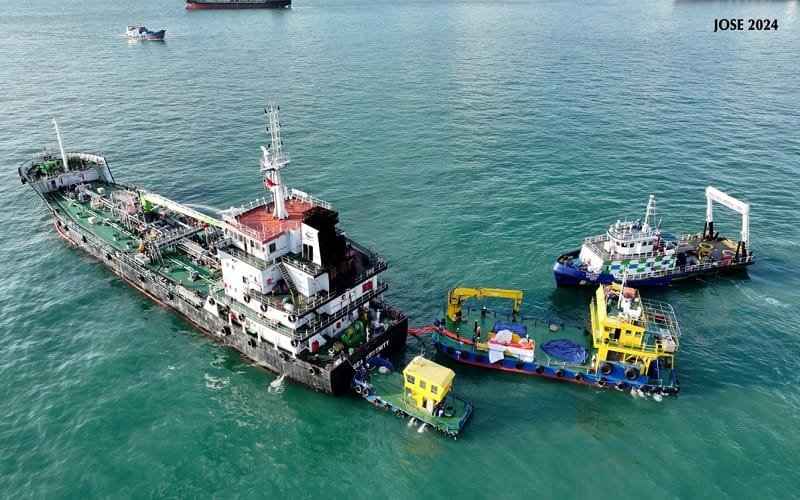The Maritime and Port Authority of Singapore (MPA Singapore) underscored the importance of emergency preparedness this morning as it led the 16th Joint Oil Spill Exercise (JOSE) in conjunction with SIBCON 2024. This high-profile exercise aimed to test and improve inter-agency and industry coordination and response to oil spill incidents in Singapore’s busy port.
The exercise involved over 100 personnel from 18 different agencies and companies, including major players in Singapore’s maritime sector. Through both a table-top exercise and a seaward deployment, participants simulated an allision between a vessel and a bunker tanker, resulting in a large oil spill. The drill not only tested response protocols but also provided an opportunity to showcase innovative technologies that can enhance oil spill recovery efforts.
Seaward Deployment and Emergency Response
As part of the seaward deployment, terminal operators from Jurong Island and Pulau Bukom activated their emergency protocols. These terminals deployed craft to spray dispersants and clean the simulated spill, in coordination with MPA patrol craft that were also present at the exercise site. Protective booms were deployed by several operators to contain the spill and minimize disruption to port operations.
In an effort to ensure a comprehensive response, representatives from nature and community groups were invited to observe the seaward exercise. This inclusion highlights Singapore’s commitment to environmental protection and community engagement in maritime safety efforts.

Innovative Technologies on Display
One of the major highlights of JOSE 2024 was the demonstration of cutting-edge technologies designed to support oil spill response. MPA partnered with several technology providers to test new equipment that could revolutionize clean-up operations.
KOAI Co., Ltd.’s KOBOT
This compact, remote-operated oil recovery robot was designed specifically for shallow waters, where traditional skimmers are less effective. The KOBOT can be deployed using a lightweight crane and operated by a single person, making it a highly efficient solution for small-scale spills in hard-to-reach areas.
BKR Engineering’s Laser Oil-Stain Cleaning Device
BKR showcased its advanced oil-stain cleaning technology, which uses intense laser beams to vaporize oil stains. This device complements existing high-pressure water jets and is especially useful for final clean-up stages on canal walls and rock bunds.
Hyperspectral Imaging Technology
MPA is exploring the use of hyperspectral imaging in partnership with the Technology Centre for Offshore and Marine, Singapore (TCOMS), and ST Engineering’s Commercial Aerospace division. This technology enhances underwater oil detection by capturing a broad spectrum of wavelengths, making it easier to distinguish oil from water in challenging environments, such as low-light conditions.
These technologies were tested during the exercise as part of Singapore’s ongoing efforts to strengthen oil spill response capabilities and provide opportunities for innovators to trial new solutions in real-world scenarios.
Collaboration Across Agencies and Companies
The exercise brought together a diverse group of agencies and companies, all of which play a crucial role in maintaining maritime safety and environmental protection in Singapore. Participants included:
- Building and Construction Authority
- JTC Corporation
- National Environment Agency
- National Parks Board
- PUB, Singapore’s National Water Agency
- Sentosa Development Corporation
- Singapore Food Agency
- Singapore Land Authority (SLA)
- Singapore Salvage Engineers Pte Ltd
- Avetics Global Pte. Ltd.
- Skyscapist Pte Ltd
- Advario Helios Singapore Pte. Ltd.
- ExxonMobil Singapore
- Shell Singapore Pte. Ltd.
- Vopak Terminals Singapore Pte. Ltd.
- Equatorial Marine Fuel
- ITOPF Limited (Singapore)
These entities worked closely with MPA to ensure the success of the exercise, demonstrating the strength of Singapore’s maritime safety framework.
MPA Singapore’s Role in Global Bunkering
Singapore remains the world’s largest bunkering hub, with over 49 million tonnes of marine fuel sold annually. By implementing cutting-edge digital bunkering practices and maintaining strict regulatory standards, the city-state continues to lead the industry in innovation, transparency, and operational efficiency.
As the region’s leading bunkering hub, the ability to respond effectively to potential oil spills is crucial. Exercises like JOSE not only test Singapore’s operational readiness but also provide a platform for the maritime community to explore new ways of tackling oil spill incidents.
The 16th Joint Oil Spill Exercise reaffirmed Singapore’s commitment to ensuring maritime safety through preparedness and collaboration. MPA’s focus on testing new technologies alongside traditional response measures shows a forward-thinking approach that keeps Singapore at the forefront of maritime safety innovation.
Source MPA Singapore

